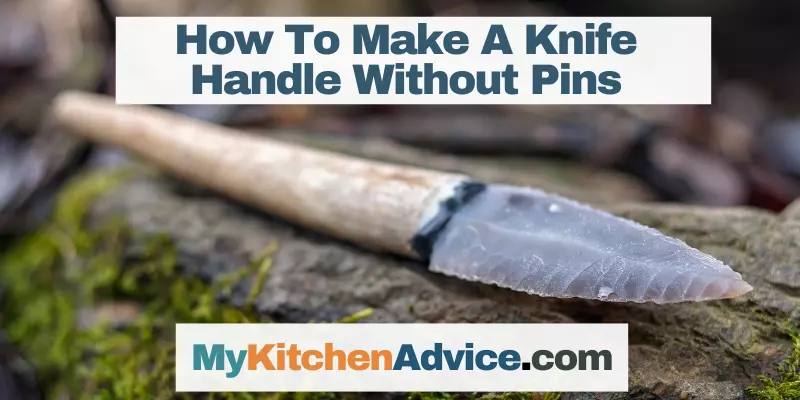Making a knife handle is an essential skill for anyone who enjoys the art of knife-making. One common way of securing the handle to the knife blade is by using pins. However, pins can be tricky to work with and may not be aesthetic. Fortunately, it is possible to create a knife handle without pins.
One way to make a knife handle without pins is to use epoxy glue to secure the handle scales to the tang. The tang should be roughed up for a strong bond. Alternatively, you could use a wrapping technique such as paracord or leather to secure the handle scales to the tang.
In this article, we will explore how to make a knife handle without pins and provide you with step-by-step instructions to get started.
10 Steps To Make A Knife Handle Without Pins: DIY Process
Building the knife handle without pins has hurdles as the process is slightly tricky. As you won’t be using pins to parts of the handles, the method is different but simple. Have a look at the step-by-step guide below to refer to the DIY process.
Step 1: Select Handle Material
Start by selecting the materials for your knife handle. You’ll need two pieces of handle material (such as wood, bone, or synthetic materials) and some epoxy glue. Make sure the materials are the right size and shape for your knife blade.
Step 2: Sand The Material
Sand the surfaces of the handle material that will be in contact with each other. This will help the epoxy bond the two pieces together.
Step 3: Apply Glue
Apply a thin layer of epoxy glue to one of the handle pieces. Use a brush or a toothpick to spread the glue evenly over the surface.
Step 4: Attach The Parts
Press the two handle pieces together firmly. Make sure the edges line up and the handle is symmetrical. Wipe off any excess glue with a damp cloth.
Step 5: Clamp Together
Clamp the handle together using a vise or a clamp. This will help the epoxy set evenly and prevent the handle from shifting.
Step 6: Leave To Dry
Let the epoxy dry for at least 24 hours. Check the manufacturer’s instructions for the recommended drying time.
Step 7: Shape By Sanding
Once the epoxy is dry, use a belt sander or a hand file to shape the handle to your desired shape. Take care of not sanding too much material away, especially near the edges.
Step 8: Polish By Sanding
Sand the handle smooth using a series of sandpapers, starting with coarse grit and gradually moving up to fine grit. This will give the handle a polished finish.
Step 9: Apply Sealant
Apply a coat of sealant or finish to the handle to protect it from moisture and wear. Use a brush or a cloth to apply the finish evenly, and let it dry according to the manufacturer’s instructions.
Step 10: Attach With Glue
Your knife handle without pins is now ready to be attached to the blade. Use a strong adhesive or epoxy glue to attach the handle to the blade, following the manufacturer’s instructions. Make sure the handle is securely attached and won’t come loose during use.
5 Tips To Maintain Knife Handle Without Pins: Best Tips
As knife handles are generally attached to pins, pinless handles require care. Though not fragile, they may break or crack a bit if not used cautiously. Proper maintenance and care are essential to keep your pinless knife handle in good condition and prolong its lifespan.
Hence, I have a few valuable tips to maintain a knife handle without pins.
1. Keep it clean:
After using your knife, wipe the handle with a clean, damp cloth to remove any dirt, grime, or food residue. Avoid using harsh chemicals or abrasive cleaners as they can damage the handle material.
2. Avoid moisture:
Excessive exposure to moisture can cause the handle material to swell, warp, or crack over time. Avoid leaving your knife in water, and always dry the handle thoroughly after cleaning it.
3. Oil the handle:
Applying a thin coat of mineral oil or other food-safe oil to the handle can help protect it from moisture and keep it looking its best. Be sure to wipe off any excess oil with a clean cloth.
4. Store it properly:
When not in use, store your knife in a dry place away from direct sunlight and moisture. A knife block, sheath, or magnetic strip can help protect the handle and keep the blade safe.
5. Check for damage:
Regularly inspect your knife handle for any signs of damage, such as cracks, chips, or splinters. If you notice any issues, stop using the knife and have it repaired or replaced by a professional.
FAQs:
What Materials Can Be Used To Make A Knife Handle Without Pins?
A knife handle can be made from a wide range of materials, including wood, bone, horn, antler, micarta, G-10, carbon fiber, and more. When making a knife handle without pins, it is important to choose a material that can provide a secure and durable grip, as well as withstand the wear and tear of everyday use.
One popular material for knife handles without pins is stabilized wood impregnated with resin and cured. Other options include synthetic materials like Micarta and G-10, which are lightweight, and easy to work with. Natural materials can be used too, but they may require more specialized tools and techniques.
What Are The Techniques For Shaping a Knife Handle Without Pins?
There are various techniques for shaping and finishing a knife handle without pins, depending on the materials and tools being used. One common method is to use a file or sandpaper to shape the handle to the desired size and shape. Another technique is to use a carving knife or chisel to create intricate designs.
Some knife makers also use heat to shape and mold materials like wood or plastic to the blade. Finishing the handle can involve sanding, polishing, or applying a protective coating to the material. It’s important to take care when shaping and finishing a knife handle without pins to ensure a secure fit and comfortable grip for the user.
How Do You Ensure A Secure Fit Between The Blade And The Handle Without Using Pins?
When making a knife handle without pins, it’s important to ensure a secure fit between the blade and the handle. One method is to use a strong adhesive, such as epoxy, to bond the blade tang to the inside of the handle. Before applying the adhesive, the tang should be roughened and cleaned to create a strong bond.
Another technique is to use a tight friction fit, where the handle is shaped to fit tightly around the blade tang without any gaps. This requires careful shaping and fitting to ensure a secure and snug fit. Additionally, some makers may incorporate other features, such as a bolster or a lanyard hole, to add extra stability and security to the handle.
What Types Of Knives Are Best Suited For A Handle Without Pins?
The type of knife that is best suited for a handle without pins is a full-tang knife. A full-tang knife is a type of knife where the blade extends all the way through the handle and is secured with epoxy or another adhesive. This type of knife provides a strong and stable foundation for the handle without the need for pins.
However, it is important to note that not all full-tang knives are created equal, and the thickness and width of the tang can affect the strength and stability of the handle. It is important to choose a full-tang knife with a sturdy and well-made tang that will support the handle without any additional reinforcement from pins.
Can A Knife Handle Without Pins Be As Durable As One With Pins?
A knife handle without pins can be just as durable as one with pins, depending on the materials and construction techniques used. Without pins, the handle may require additional shaping and finishing to ensure a secure fit between the blade and the handle.
It is important to select strong and durable materials for the handle, such as hardwoods, stabilized wood, or synthetic materials. Proper construction techniques, such as using epoxy or other adhesives to bond the blade to the handle, can ensure a strong and lasting connection.
How Do You Choose The Right Size And Shape For A Knife Handle Without Pins?
Choosing the right size and shape for a knife handle without pins is important for both functionality and aesthetics. The handle should fit comfortably in the user’s hand and provide a secure grip. When selecting the shape of the handle, it’s important to consider the type of knife and its intended use.
For example, a hunting knife may benefit from a more contoured handle with a finger guard, while a kitchen knife may require a straighter handle for a more comfortable grip during prolonged use. It’s also important to consider the material used for the handle, as some materials may require more shaping or sanding to achieve the desired size and shape.
Are There Any Disadvantages To Making A Knife Handle Without Pins?
Yes, there are some potential disadvantages to making a knife handle without pins. Without pins, the handle may be less stable and could potentially shift or rotate on the blade over time. The absence of pins may make it more difficult to achieve a strong and secure attachment between the blade and the handle.
Without pins to hold everything together, the handle may also be more prone to cracking or breaking if subjected to excessive stress or pressure. However, with proper design and construction techniques, many of these issues can be mitigated or avoided entirely.
Conclusion:
In conclusion, making a knife handle without pins can be achieved through several methods, such as using adhesives, bolts, or epoxy resins. Each method has its advantages and disadvantages, and the choice ultimately depends on the preferences and requirements of the knife maker.
It’s essential to ensure that the handle material is durable, comfortable to grip and provides a secure attachment to the blade. With the right materials and techniques, making a knife handle without pins can produce a beautiful and functional knife that can stand the test of time.


